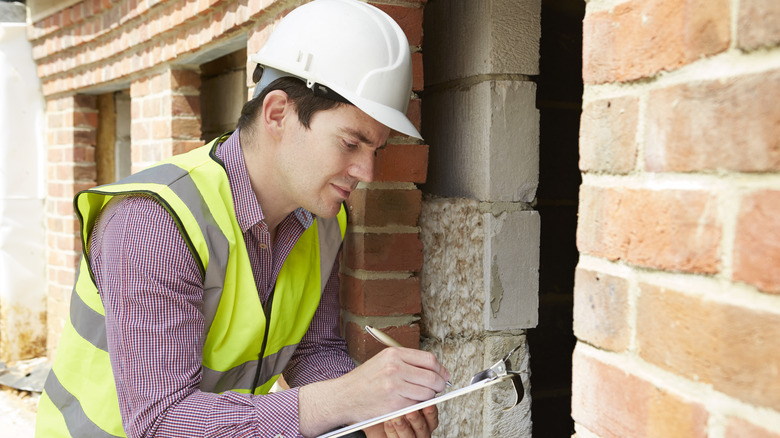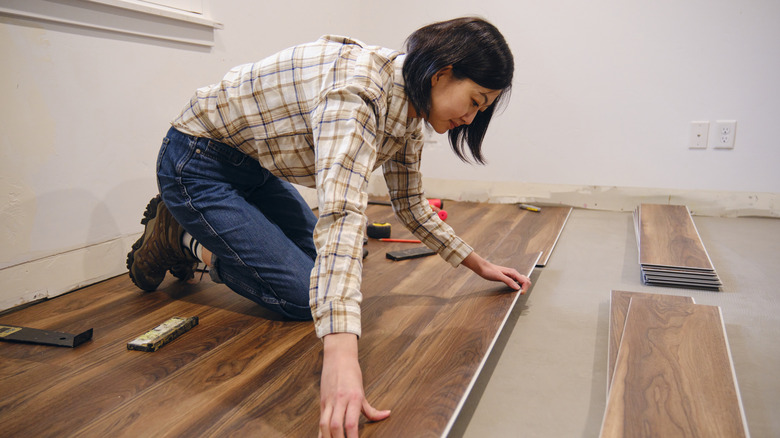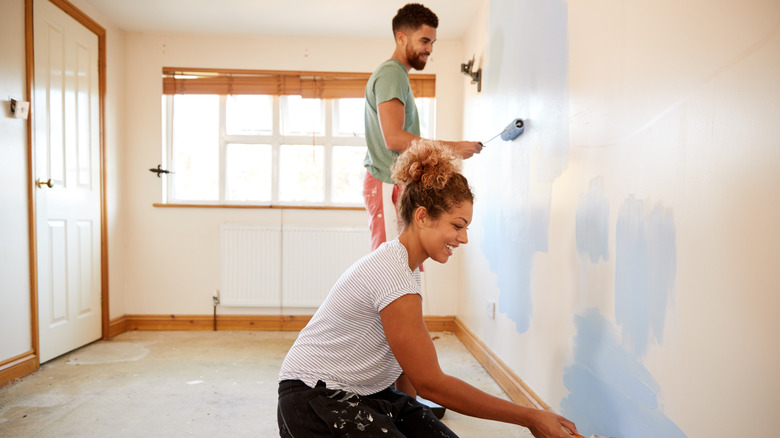The Correct Order To Structure Your Home Renovation Project, According To Experts
Undertaking any sort of home design project can be tough, but revamping an entire home or a large area is another thing entirely, not to mention an expensive task. The average cost of renovating a home in the U.S. in 2024 ranged from $30,000 to a whopping $120,000, so it's definitely something you want to get right the first time. With the number of decisions to make, both small and big, it's no wonder that the process can quickly turn from something you were excited about to something you just want to get done. Luckily, Dan and Steve Tuer from Refresh Home Improvements exclusively revealed to House Digest their best tips for where to start with a big renovation project and which order to carry out the tasks.
Whether it's picking out a countertop for your kitchen or trying to decide on the perfect floor for your bathroom, sometimes it's difficult to even know where to start with a large-scale project. When you factor in things like electrical, plumbing, and structural issues such as tearing down and putting up walls, deciding which decisions should be prioritized first becomes even more muddled. However, by keeping the Tuers' tips in mind before beginning your renovation, things should feel less stressful off the bat.
First perform a mini inspection of common problem areas
When embarking on a renovation, you're probably tempted to jump right into designing your dream bedroom or picking out the backsplash for your kitchen, but what you should actually do is focus on the less-fun stuff. As Dan and Steve Tuer exclusively shared with House Digest, "When remodeling a home, we think it's crucial to start by inspecting the common problem areas first. You'd be surprised how many potential issues can lurk behind walls, under your shingles, around your foundation, or deep in your drains. In our experience, you should always make sure the 'boring stuff' is functioning properly before spending anything on the 'fun stuff' (like a new kitchen, or principal bathroom)."
This ensures you won't have to backtrack and rip out fresh drywall or new floors to make costly repairs when something breaks internally. For example, the Tuers point out that the main drain line and basement foundations are two commonly forgotten checks that can quickly turn into expensive repairs. Imagine finishing your basement only to discover you have to remove the drywall and insulation because you have a leak. You can check if your basement is protected against water damage by checking to see if there are signs of dampness, such as stains and peeling paint, and looking outside for areas of water near your basement. As for the main drain line, the Tuers advise that you or an inspector should look for "potential clogs and cracked pipes/back-flow valves." This should be done at the very beginning of the renovation process.
Move onto the 'bones'
As mentioned, it can be easy to get caught up in the exciting part of remodeling before focusing on the practical side. But after your inspection confirms you don't need to make any major repairs, you can move on to updating the general "bones" of the house before focusing on anything cosmetic. "As a rule of thumb, we prefer to focus on the 'bones,' or the structural/foundational elements of the house before addressing cosmetic desires," the Tuers share. "Waterproofing, drains, electrical, pest control, and HVAC are all elements of a home that should be addressed before considering what tile you'll be using on the kitchen backsplash."
This makes sense since renovations often include opening up walls, exposing pipes, uncovering electrical, and giving you a peak behind the curtain, so to speak. When you open up a wall, you might notice that a pipe you would not normally see is corroding, requiring you to replace it before you continue with your bathroom remodel. Similarly, ripping back drywall because you want to move a wall to expand a room might reveal that you have mouse droppings inside, signaling you have a pest problem. Or perhaps it uncovers a set of wires that have blackened, signaling you might be steps away from an electrical fire. These are things an inspection wouldn't catch since they're hidden behind walls, but that you will spot once you begin renovating. Because of this, you're forced to first update the "bones" before moving on to the aesthetic stuff.
Focus on your most-used rooms next
Once you have gotten the boring stuff out of the way, now it's time for something a little more interesting. However, you may feel a little overwhelmed about where to actually start. The Tuers believe you should first focus on updating the rooms that get the most foot traffic. "We usually recommend our clients renovate the areas of their home that are used (and need updating) the most, first," they state. "In our experience, this tends to be kitchens, bathrooms, and laundry rooms."
You may be excited to turn the room you currently sleep in into the bedroom of your dreams, but, per the Tuers, focusing on the rooms that get the most use and require the most changes will get your house up to scratch much faster. Plan out which rooms fit this description before beginning any work. Like the Tuers say, the kitchen and bathroom are the areas you should consider remodeling, as they are two of the most important rooms in the house. When working with structural elements such as removing walls, the Tuers recommend dealing with them first before moving onto areas like flooring. If you're thinking of doing further renovations a few years in, the Tuers advise making a plan for those renovations from the start, particularly if you think you'll run into issues like wiring and plumbing that may be easier to sort out at the beginning rather than in a few years.
For your next move, determine what will bring your home the most value
After your most-used rooms are updated, consider what would bring the most value to your house. That should be your next project. "Again, every home has a different set of needs and wants. A renovated kitchen in one house may add the most value, while adding a fence around the property may add the most in another," the Tuers explain. If you have two dogs and are anxious to play with them in your backyard before the warm season is over, then investing in a fence or focusing on transforming your backyard is the correct move for you. However, if you started a small business recently and really need a dedicated space to work and build your empire, then remodeling a suitable office should be your next renovation project.
Of course, this changes if you are renovating a house to flip, or are only planning to stay there a few years before upgrading to a bigger one. In that case, you want to focus on what would bring the most value to a large pool of potential buyers. In that case, you might need to pick the brains of some professionals. "If increasing property value is your primary concern, we recommend consulting local realtors and builders to help understand what matters most to prospective homeowners in your area," the Tuers share. They will help you discern whether updating the dining room should be next or if you should transform the small third room into a gym. Their expertise will help you get more bang for your buck when it's time to sell. However, make sure to consult several professionals to get a more rounded outlook.
If you're stuck on what would bring the most value, hire a professional
When you buy a house, it can be tempting to do everything yourself in the hopes of saving some money. However, this isn't always the right option, and in fact, it can cause delays further down the line. "The best advice we can give is to work with someone who can help you achieve a design and layout for your entire home," the Tuers say. "This might seem like a large expense at first, but doing so ensures that every renovation you do not only improves that specific area of the home, but sets the next room up for success as well. This will not only lead to a more cohesive and efficient home, but a smaller budget, too."
If you hire someone to oversee the renovation process, it's more likely you'll end up with results you're satisfied with. As any amateur who has tried renovating a room themselves will tell you, it's one thing to find inspirational rooms on Pinterest but a whole other thing to bring them to life. Most of us aren't really sure how to make our dreams turn into reality. An architect will typically charge between $100 to $250 an hour. However, as the Tuers point out, you could actually end up saving money elsewhere by having a professional point out which steps are necessary and which ones can be skipped. Having someone in the know will mean you can put money into the things you need, and avoid making financial mistakes on things that don't need changing.
Move onto flooring in the end
Aside from structural changes, flooring is one of the biggest changes you can make to a home. So when exactly should you install it? The Tuers believe that this is one thing that should be left near the finish line. "One element that we tend to leave later than some renovators is the installation of new flooring. We find that holding off on flooring until the end ensures that there are fewer late-game layout changes that can leave you with unwanted thresholds and patchwork flooring. It also helps to ensure that your brand new (and expensive) floor doesn't get damaged during the renovation process."
It may sound weird, but installing flooring at the very end of a project could actually mean it turns out better. You can easily install other features like heavy cabinets without worrying about scratching the delicate flooring, and you won't have to be precious about putting your heavy tools down on the ground. It also allows you to change your mind over things like fixtures or pipes at any point of the remodeling process since you can easily move and reroute them across the floor. Plus, cleanup will be much easier with just a subfloor exposed. You won't have to put down tarps as you put up and patch drywall, and you don't need to worry about dirt settling into your new tile grout or thick construction dust coating the grooves of your brand new hardwood planks.
Finish things off with paint
Paint is a major part of any renovation, especially if you're changing several rooms. But it can be tricky to know when to call the painters in (or when you should start painting your home yourself). The Tuers believe in leaving painting until the end. "Paint can always be patched and touched up, but it looks far better when it's done once properly," they explain. "We also love the finality of leaving that one final top coat until the bitter end of the renovation."
Paint should be left to the end to avoid creating any accidental scuffs or knicks, as well as to avoid getting any dust or debris onto the wet paint. For example, if you paint first and then install your flooring, you can get dust on the walls every time you cut the wooden planks or tiles, creating a gritty texture on the drying paint. If you still need to install your trim, you can accidentally scratch the paint as you hold the wooden pieces to the wall. Or, if you still have some minor projects to complete in the room, you will still be moving ladders and tools around the space, which increases your chance of scratching or damaging the wall. But if you leave the painting to the end, the room will look pristine once the final coat is rolled.







